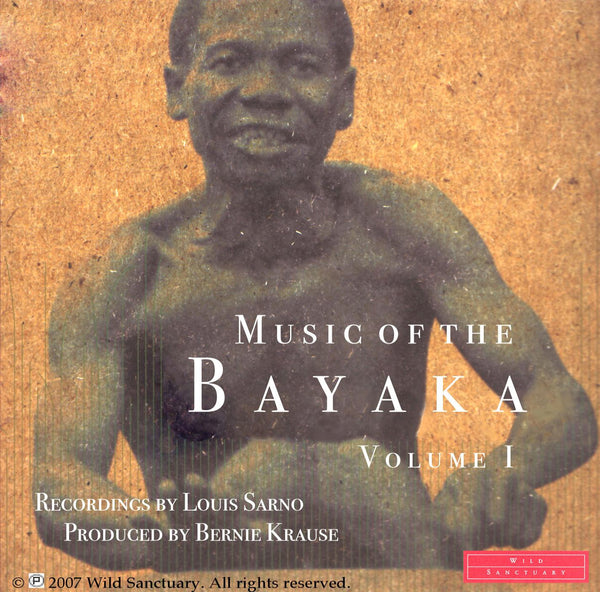The Music Of The Bayaka: Volume I
Recordist/Credit: Louis Sarno
Author of 'BAYAKA: THE EXTRAORDINARY MUSIC OF THE BABENZELE PYGMIES'
Since
1984, Louis Sarno, an American born and raised in New Jersey, has lived with and
recorded the music of the Bayaka and their surrounding habitats in the remote
areas of the Central African Republic. During this period, Sarno reflects, "...I
have grown familiar not only with the Bayaka, but also with the forest in which
they live. Their music seems nothing less than a creation of the rain forest
itself, its ultimate form of self-expression." Remove the voices of the Bayaka
from this paradise of natural soundscapes, and you remove its soul.
1. WOMEN GATHERING MUSHROOMS
Early one morning seven
women went a short way from a recently established forest camp to gather
mushrooms they had discovered the evening before. Mushroom gathering lends
itself to lyrical accompaniment, for it is not strenuous and often takes place
in the magical primary forest. The melodies are fragments of a boyobi ceremony
sung the previous evening. These astonishing pure and powerful voices
reverberate throughout the forest as the women yodel, using specially-acquired
vocal techniques combined with the acoustics of the habitat to create chords
with a single voice as notes hang in the air for long periods of time.
2. WALKING SONG
The mondum is an original Bayaka instrument much
like a harp-zither. Typically played with the forefingers of both hands the
instrument is usually placed over a pot to amplify the sound. It makes it
splendidly suited for the acoustics of the forest. Most forest camps have at
least one such instrument, but there are very few in what's called village
camps. Adamo, the musician in this 1994 recording, is using a tiny coffee can
instead of a cooking pot as a resonator. This allows him to play while walking
through the forest, hence the song's title.
3. BOYOBI (Part 1, at
spear-hunting camp)
The ceremony performed before net and spear hunts
protects hunters from harm and represents the supreme musical artistry of the
Bayaka. All members (women, men, and even children) sing creating a polyphony of
stunning beauty and complexity, along with elaborate percussion. The discordant
cries of the bobメ , the spirits who dance in boyobi, add another dimension to
the music. Life in the forest becomes on long ceremony and the boyobi can last
as long as a week. Because there are so many disparate groups (men, women,
children, and those playing the role of spirits) spread throughout the forest,
this music is particularly difficult to record in one piece.
4. WEDDING
SONG
A casual Bayaka affair, there is no regular wedding ceremony to
celebrate the event. Typically an all night performance, the limboku is sung by
the bride and an entourage of women as they wander slowly through the camp
singing and dancing with highly charged sexual innuendo. This ceremony is
strictly off limits to boys and men who are confined to their houses during this
performance. This segment was the small part that Sarno was allowed to record.
5. BENEDICTION ON A SETTLEMENT
Women's music, the yeyi (yodel)
is performed to bring benediction on a camp or settlement. Typically it begins
in the small hours of the morning with the yodels of a single woman, reinforced
by the drinking of a special medicine, and who is soon answered by others. The
main singer is a woman named Eloka.
7. BOYOBI (Part 2)
The
ceremony has been performed over the period of several days, now. Dressed in a
bewildering array of green phosphorescent body designs, the bob (high falsetto
yodels) and whistles make up the acoustic theme of this part of the ceremony.
Meanwhile, animals, headless creatures, even military-like figures with glowing
shoulder pads appeared and vanished in the course of the night, dancing and
charging about with reckless abandon in the profound darkness.
8.
MONDUME WITH PERCUSSION
In the wee hours of the morning, when everyone
had retired after a night of boyobi, Matubi sat up and strummed on his mondum,
serenading our forest camp until shortly before dawn. He was joined on the stick
percussion by Mitumbi and Mosio. Mabuti sings that one must not follow the path
of jealousy, for it makes the heart evil.
9. BOYOBI (Parts 3 & 4)
Taken from the final night of the boyobi presented earlier, this was the
last iteration of that music for over two weeks. The first song is a lovely
rendition of what one might call the main theme of the Bayaka's 3-month forest
sojourn. It is a very old melody. The second track begins with the falsetto
screeches and rapid speech of the bob, who demanded that the women keep singing,
for the bob's energy for dancing had yet to be exhausted. At the end, rhythmic
cries dominate, creating a coda-like part of the boyobi called the esim that
customarily follows each song. Phosphorescent figures during this dance sequence
become truly spectacular.
10. FUNERAL SONG
When a woman has
died, and after her burial, the women assemble to sing limboku, a farewell
ceremony to the woman, reestablishing the natural and harmonious relationship
between community and cosmos.
11. WOMEN OFF TO GATHER PAYU
Shortly after dawn a group of five women set out from the forest camp to
collect payu singing yeyi songs as they travel. Voices resonating and coalescing
with the biophonies, the women always sing as they go off into the forest to
gather water, join the men on a net hunt, or gather mushrooms.
THE MUSIC OF THE BAYAKA | Volume I© 2007 Wild Sanctuary. All rights reserved.
This is a high-quality zipped album delivered in 192 kpbs MP3 format. This can be listened to on your home computer, burned to a CD, or carry it with you on your iPod or other MP3 player.



